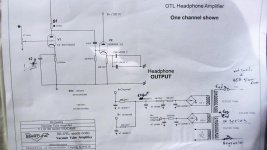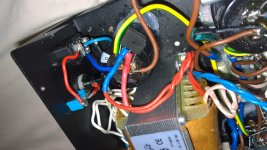Hi all, I have built this circuit but I have a feeling that the first smoothing capacitor should be connected to neutral of the 3 pin socket and not earth like it is now, please see photo, could someone please tell me which is correct, sorry, I'm still learning and as usual thanks in advance, Ian
Ps, this is 240v, I'm sorry the photo is upside down, please rotate if need be.
Ps, this is 240v, I'm sorry the photo is upside down, please rotate if need be.
Attachments
Last edited:
Never ever connect anything from the secondary side of a transformer to N (or L).
If the design permits then connecting parts of the secondary circuitry to mains earth is permisable, and in fact this happens all the time in equipment with a grounded chassis where the chassis is tied to the zero volt line of the power supply.
So the answer NO. Never connect anything to neutral. Imagine what would happen if the equipment was connected to a wall socket of reversed polarity, something that is actually a common occurance.
If the design permits then connecting parts of the secondary circuitry to mains earth is permisable, and in fact this happens all the time in equipment with a grounded chassis where the chassis is tied to the zero volt line of the power supply.
So the answer NO. Never connect anything to neutral. Imagine what would happen if the equipment was connected to a wall socket of reversed polarity, something that is actually a common occurance.
Its never easy working off photos, but if the green/yellow wire connects to mains earth then it is safe up to a point (but incorrect) and you should really connect the mains earth to chassis to make the whole unit safe.
The audio circuitry doesn't actually need the connection, and in fact in some cases it can cause problems with audible hum as ground loops are created. Its also common to 'loosely' tie the power supply zero volt line to chassis via a low value resistor but there are no hard and fast rules and each case has to be looked at on merit.
The only purpose of the mains earth is safety and I would say that for safety you absolutely must connect mains earth to chassis for your particular build as shown here.
The audio circuitry doesn't actually need the connection, and in fact in some cases it can cause problems with audible hum as ground loops are created. Its also common to 'loosely' tie the power supply zero volt line to chassis via a low value resistor but there are no hard and fast rules and each case has to be looked at on merit.
The only purpose of the mains earth is safety and I would say that for safety you absolutely must connect mains earth to chassis for your particular build as shown here.
That is dangerously wired as is.
The only connection to the ground lug that should EVER be made is a short wire to the chassis and nothing else! This connection must be made with a very secure bolted-on lug through the chassis. Do not share this connection with anything else if you can help it.
Once the ground wire is attached correctly, then the ground of the circuit is to be attached to the chassis as well, but at a separate location. Either directly attach a wire from the ground of your circuit to it's own bolt on the chassis, or make the connection through a suitable ground loop breaker circuit, like this-
http://sound.whsites.net/earth-f4.gif
here is an article that will go into some good logic about the safety factor...
Earthing (Grounding) Your Hi-Fi - Tricks and Techniques
The only connection to the ground lug that should EVER be made is a short wire to the chassis and nothing else! This connection must be made with a very secure bolted-on lug through the chassis. Do not share this connection with anything else if you can help it.
Once the ground wire is attached correctly, then the ground of the circuit is to be attached to the chassis as well, but at a separate location. Either directly attach a wire from the ground of your circuit to it's own bolt on the chassis, or make the connection through a suitable ground loop breaker circuit, like this-
http://sound.whsites.net/earth-f4.gif
here is an article that will go into some good logic about the safety factor...
Earthing (Grounding) Your Hi-Fi - Tricks and Techniques
Last edited by a moderator:
One other thing i see, and it has nothing to do with the original topic, is that there is no load resistor shown on the output side of the output caps.
If headphones are unplugged while the amp is on, there will be significant DC voltage at the output. At the very least you may damage your headphones. At worst you have a shock hazard.
Put a 1M resistor from the cap to ground.
If headphones are unplugged while the amp is on, there will be significant DC voltage at the output. At the very least you may damage your headphones. At worst you have a shock hazard.
Put a 1M resistor from the cap to ground.
One other thing i see, and it has nothing to do with the original topic, is that there is no load resistor shown on the output side of the output caps.
If headphones are unplugged while the amp is on, there will be significant DC voltage at the output. At the very least you may damage your headphones. At worst you have a shock hazard.
Put a 1M resistor from the cap to ground.
Its only a low voltage output so doesn't need a resistor.
If the output was on the anode side then I would agree with you.
- Status
- This old topic is closed. If you want to reopen this topic, contact a moderator using the "Report Post" button.
- Home
- Amplifiers
- Tubes / Valves
- Capacitor/ neutral or earth


 Rod Elliot does not want his pictures posted elsewhere without his permission, he is fine with just links...
Rod Elliot does not want his pictures posted elsewhere without his permission, he is fine with just links...